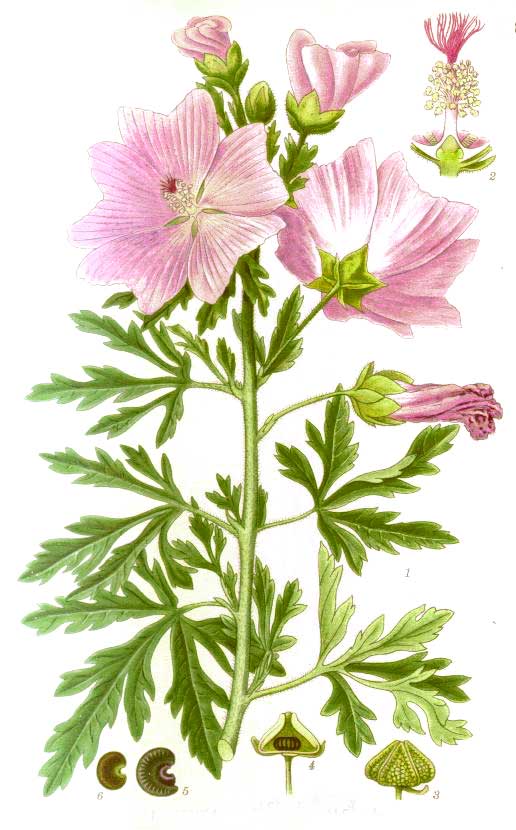
Malva alcea
Classification System: APG IV
Superregnum: Eukaryota
Regnum: Plantae
Cladus: Angiosperms
Cladus: Eudicots
Cladus: Core eudicots
Cladus: Rosids
Cladus: Eurosids II
Ordo: Malvales
Familia: Malvaceae
Subfamilia: Malvoideae
Tribus: Malveae
Genus: Malva
Sectio: M. sect. Bismalva
Species: Malva alcea
Name
Malva alcea L.
References
Linnaeus, C. 1753. Species Plantarum. Tomus II: 689. Reference page.
USDA, ARS, Germplasm Resources Information Network. Malva alcea in the Germplasm Resources Information Network (GRIN), U.S. Department of Agriculture Agricultural Research Service. Accessed: 07-Oct-06.
Vernacular names
العربية: خبازة خطمية
čeština: sléz velkokvětý
Cymraeg: Hocysen-fwsg fawr
Deutsch: Rosen-Malve, Siegmarswurz
English: hollyhock mallow, greater musk-mallow, cut-leaved mallow, vervain mallow
español: malva montés, malvavisco salvaje
suomi: Ruusumalva
français: Mauve alcée, Mauve alcee
hornjoserbsce: Stojaty šlěz, Stojaty šlez, Stojata malwa
lietuvių: Aukštoji dedešva
Nederlands: Vijfdelig Kaasjeskruid
Runa Simi: Hatun rup'u
slovenčina: slez liečivý
svenska: Rosenmalva, Rosenkattost
Malva alcea (greater musk-mallow, cut-leaved mallow, vervain mallow or hollyhock mallow) is a plant in the mallow family native to southwestern, central and eastern Europe and southwestern Asia, from Spain north to southern Sweden and east to Russia and Turkey.[1][2][3]
Description
It is a herbaceous perennial plant growing to 50–125 cm tall, with stems covered in stellate hairs, meaning they branch at the free end into several strands. The leaves are 2–8 cm long and 2–8 cm broad, palmately lobed with five to seven blunt lobes; basal leaves on the lower stem are very shallowly lobed, those higher on the stems are deeply divided, with digitate finger-like lobes. The flowers appear singly near the apex of corymbose racemes growing from the leaf axils in summer to early fall. They are 3.5–6 cm diameter, with five sepals and five bright pink petals, and have no scent. The bracteoles that make up the epicalyx are ovate and wide at the base where they are fused with the calyx. The fruit is a hairless disc-shaped schizocarp 4–8 mm diameter, containing several seeds, the seeds individually enclosed in a glabrous or hairy mericarp. It has a chromosome count of 2n=84.[3][4][5][6]
Gallery
Flowers of Malva alcea
Close-up on flower of Malva alcea
Flower of Malva alcea
Leaf of Malva alcea
Ecology
It is most common in drier soils in thickets, along paths and in waste places. Natural hybrids with the closely related Malva moschata are occasionally found. In central Europe it grows at altitudes of up to 2,000 m.[3]
Cultivation and uses
It has been widely grown outside of its native range as an ornamental plant. Several cultivars exist such as 'Fastigata', an upright form, and 'Alba', a white flowered form. In some areas, such as the northeastern United States, the plant has escaped from cultivation and become naturalised. It is very similar to, and often confused with Malva moschata.[7]
Synonyms
Malva abulensis Cav.
Malva bilobata Merino in Brotéria
Malva bismalva Bernh. ex Lej.
Malva fastigiata Cav.
Malva italica Pollini
Malva lagascae Lázaro Ibiza & Andrés Tubilla
Malva lobata Cav.
Malva morenii Pollini
Malva ribifolia Viv.
References
Flora Europaea: Malva alcea
Med-Checklist: Malva alcea
Blamey, M. & Grey-Wilson, C. (1989). Flora of Britain and Northern Europe. ISBN 0-340-40170-2
(in German) Schmeil, O., Fitschen, J., & Seybold, S. (2006). Flora von Deutschland, 93. Auflage. p. 422. Quelle & Meyer Verlag, Wiebelsheim. ISBN 3-494-01413-2.
Flora of NW Europe: Malva alcea[permanent dead link]
Malvaceae Pages: Musk Mallows (section Bismalva)
Huxley, A., ed. (1992). New RHS Dictionary of Gardening. Macmillan ISBN 0-333-47494-5.
Retrieved from "http://en.wikipedia.org/"
All text is available under the terms of the GNU Free Documentation License

